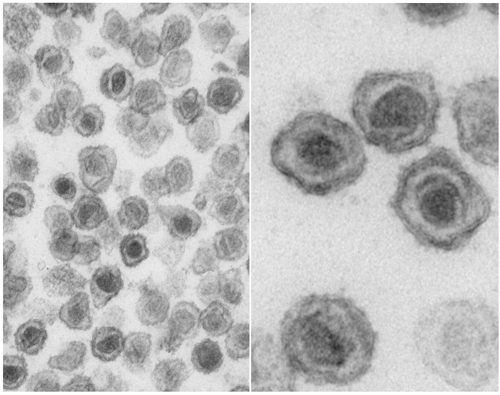

Chronic fatigue syndrome (CFS) is a disease characterized by fatigue and chronic inflammation that can last years and may affect ~1% of the world’s population. The etiology of the disease is unknown, although several viruses have been suggested to be involved, including enteroviruses and herpesviruses.
The retrovirus XMRV (xenotropic Moloney murine leukemia virus-related virus) was recently identified in the tumor tissue of individuals with prostate cancer. XMRV nucleic acid was detected by polymerase chain reaction in the blood of 68 out of 101 samples (67%) from CFS patients. The virus was also found in 8 of 213 samples (3.7%) from healthy individuals. Antibodies to the virus were found in 19 of 30 CFS blood samples, but not in 16 healthy control specimens. Viral proteins were identified in both B and T lymphocytes, and infectious virus could be cultured from these cells.
Nucleotide sequence analysis of two XMRV genomes cloned from patient samples revealed that the virus is >99% identical to the virus identified in prostate cancers. Nevertheless, the two XMRV genomes are sufficiently different to suggest that the two CFS patients were independently infected.
These findings must be verified by more extensive analysis of CFS and healthy populations worldwide. But XMRV is real and its presence in people raises many questions.
Where did XMRV come from? The retroviruses identified in patients with CFS or prostate cancer are highly related (more than 90% DNA sequence identity) to a group of viruses of wild and laboratory mice called xenotropic murine leukemia virus. Xenotropic MLVs are endogenous retroviruses of mice – the viral DNA is integrated into the mouse genome. Mice produce low levels of the virus – a few infectious viruses per milliliter of blood – but the virus cannot reinfect mouse tissues (hence the name ‘xenotropic’, meaning a virus that can grow in species other than that of its origin). These viruses can infect many cells, including human cells. Therefore it is not unreasonable to hypothesize that XMRV is a xenotropic MLV that crossed from mice to humans. Remember the zoonotic pool?
Does XMRV cause CFS? While the presence of XMRV in 67% of CFS samples seems impressive, it could be misleading. For example, the samples could be from regions where XMRV infection is common. Alternatively, patients with CFS could be more susceptible to infection. This is why more extensive epidemiological studies must be done.
How would XMRV be transmitted? Since XMRV is in the blood, it could be transmitted via transfusion, intravenous drug use, or by any other blood-borne route. Whether or not other modes of transmission (respiratory, sexual) are involved depends on where else the virus is found in humans.
How would XMRV cause disease? One idea is that infection with XMRV, which is present in high titers in the blood, leads to a continuous, long-term immune response. Think about how you feel during the 5 days of an influenza virus infection. A vigorous immune response exhausts the body, especially when it is chronic.
Many CFS patients develop cancer. It will be interesting to determine if XMRV integration into human DNA activates oncogenes, leading to cell transformation.
What about the 3.7% of healthy people who have XMRV? If this number is representative of the general population, then many millions of individuals would harbor the virus. XMRV could be involved in other diseases of unknown origin.
It will take time to answer the many questions raised by the discovery of XMRV. The good news is that some of the anti-retroviral drugs licensed for treating AIDS can be immediately tested for their efficacy against CFS.
Urisman A, Molinaro RJ, Fischer N, Plummer SJ, Casey G, Klein EA, Malathi K, Magi-Galluzzi C, Tubbs RR, Ganem D, Silverman RH, & DeRisi JL (2006). Identification of a novel Gammaretrovirus in prostate tumors of patients homozygous for R462Q RNASEL variant. PLoS pathogens, 2 (3) PMID: 16609730
Lombardi VC, Ruscetti FW, Das Gupta J, Pfost MA, Hagen KS, Peterson DL, Ruscetti SK, Bagni RK, Petrow-Sadowski C, Gold B, Dean M, Silverman RH, & Mikovits JA (2009). Detection of an Infectious Retrovirus, XMRV, in Blood Cells of Patients with Chronic Fatigue Syndrome. Science (New York, N.Y.) PMID: 19815723
Schlaberg R, Choe DJ, Brown KR, Thaker HM, & Singh IR (2009). XMRV is present in malignant prostatic epithelium and is associated with prostate cancer, especially high-grade tumors. Proceedings of the National Academy of Sciences of the United States of America, 106 (38), 16351-6 PMID: 19805305

Pingback: Science retracts paper on detection of XMRV in CFS patients | StigmaBot